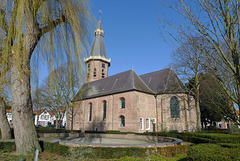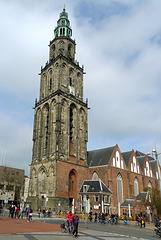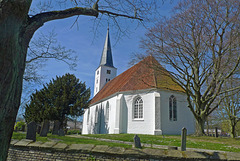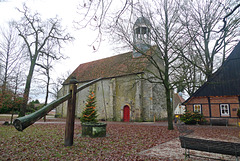
Nederland: kerken en kloosters
Folder: Nederland - the Netherlands
Foto's van het interieur en exterieur van kerkelijke gebouwen, zoals kerken, kapellen en kloosters.
Nederland - Groede, Grote Kerk
| |
|
|
|
The ‘Grote Kerk’ (Big Church) in Groede was built mid 13th century and belongs to the Flemish Hall Churches. The dating and architecture of the building refers to the former unity of Zeelandic and Flemish Flanders. From the beginning of the 14th century many of this kind of churches were built along the Flemish coast. The church in Groede has a remarkable octagonal tower.
Because Groede was flooded from 1583-1613 the church suffered a lot. In 1619 the choir was restored and further recovery followed from about ten years later. From 1618 the south aisle served almost two centuries as Walloon church; around 1685 this part of the church was separated from the rest.
In 1868 the ‘Grote Kerk’ was substantially rebuilt and completely plastered on the outside. During World War II Groede was spared from bombardments as it became a ‘red cross village’ by painting a huge red cross on the tower of the church.
In 1970 the church was completely restored and plaster was removed. The building fell into a very bad condition and in 2010 a new restoration was necessary. Since then the name of the church has been changed into ‘Grote Kerk’. Nowadays it is used again for services, but also for art exhibitions and other events.
Nederland - Groet, Witte Kerkje
| |
|
|
|
The single nave ‘Witte Kerkje’ (White Little Church) is dating back to the year of 1639. The tower is made of wood and has an octagonal spire. It is located on a so called ‘terp’, a man made elevation.
In 1825 the church was thoroughly restored. During World War II the building was used as a school. German soldiers have pulled the bell from the tower for use of the material in the war industry. A new bell was donated and replaced by the municipality of Schoorl in 1949.
Since 1972 the ‘Witte Kerkje’ has been recognized and protected as a Dutch national monument. Nowadays the church is still used for services.
During my visit the church was closed, so I couldn’t take an interior picture. If interested take a look at: www.goo.gl/aTcZC6
Nederland - Groet, Witte Kerkje
| |
|
|
|
The single nave Witte Kerkje (Little White Church) is dating back to the year of 1639. The tower is made of wood and has an octagonal spire. It is located on a so called “terp”, a man made elevation.
In 1825 the church was thoroughly restored. During World War II the building was used as a school. German soldiers have pulled the bell from the tower for use of the material in the war industry. A new bell was donated and replaced by the municipality of Schoorl in 1949.
Since 1972 the ‘Witte Kerkje’ has been recognized and protected as a Dutch national monument. Nowadays the church is still used for services.
The statue near the church, Wasvrouwen (Laundry Women), is a reminder of the old days, when the lawn was used as a bleaching field for laundry.
Nederland - Groningen, Martinitoren en kerk
| |
|
|
|
The 'Martinitoren' is with its height of 97 metres the most well known and remarkable landmark of the city of Groningen.
Originally the church (Martinikerk) had an indoor tower, but after it collapsed a new tower was built (between 1470 and 1550) west of the main church. The inhabitants of Groningen call it ‘d'Olle Grieze’ (Old Grey One) after the colour of the bricks.
The 'Martinikerk' got its name from Sint Martinus or Sint Maarten (Saint Martin) and still some murals of him as well as others can be seen in the choir of the church. These beautiful paintings are dating back to the year of 1545. The ceiling has a warm blue colour.
The nave of the church is really impressive and has one of the biggest baroque organs in northern Europe. The construction of this organ started already in 1480 and was finished in the 19th century.
Nederland - Haarlem, Grote of St.-Bavokerk
| |
|
|
|
The reformed Grote of St.-Bavokerk (Great or St.-Bavo Church) is a former Catholic cathedral. The church is a late Gothic cross-basilica with a slim line cross tower. The very first St. Bavo Church was already mentioned in 1245 and was considered prominent, among other things because of its belfry. The Church is built in basilical style: the nave is twice as broad as the side aisle.
The direct predecessor of the present church consisted from a choir, nave, transept and a west tower which was tall enough to be used as a watchtower for firemen. This tower had a peak made of slate and probably also lead and possibly also a small lantern. It was provided with a weathercock and a clock with a bell. In 1423/1433 a richly decorated Font Chapel was built against the west side of the church with a charming baptismal font in it with a wrought-iron tap.
The design for the stone tower was made in 1502. The tower seemed to be too heavy for the crossing pillars and one of the pillars sank; some gravestones around it cracked. Between 1514 and 1517 the tower was then broken off again and replaced by a wooden crossing tower covered with lead. The dimensions of the 76 meters high tower are immense: 35 to 40 meters height, an ‘onion’ of 3 meters high and in diameter; a cross of 550 kg, a cock of 65 kg and a carillon with 47 bells of more than 10.000 kg and the weight of the leaded paneling about 85.000 kg. Some more facts and figures of the church: length 108 meters, width of the nave + side aisles 31 meters, widest point of the church 47 meters, height of the nave 29 meters,
The Grote of St.-Bavokerk was and still is an important landmark for the city of Haarlem and has dominated the city skyline for centuries.
Nederland - Haarlem, Grote of St.-Bavokerk
| |
|
|
|
The Grote of St.-Bavokerk (Great or St.-Bavo Church) is located in the center of the city of Haarlem. With its 76 meters high wooden tower - covered with lead - the church is a well known landmark. The medieval gothic cruciform church is one of the largest in the Netherlands.
The impressive interior of the gothic church offers a lot of splendid (architectural) highlights. Unique in the church are the beautiful wooden ceiling vault, the many stained-glass windows and the the floor, which consists entirely of 1.500 gravestones; the oldest is dating back to the 15th century. Until 1831 graves were allowed in the church, and many illustrious Haarlemmers through the centuries are buried there.
The choir - built in 1370-1400 - is closed off at the front by a masterpiece of medieval craftsmanship: a copper choir screen from 1517. The choir stalls are dating back to the beginning of the 16th century; the coats of arms were applied later.
The famous Müller organ was played by many well known musicians, including Mendelssohn, Händel and the 10-year-old Mozart. The organ counts 5.068 pipes and is almost 30 meters high.
Nederland - Haarlem, Bakenesserkerk
| |
|
|
|
The Bakenesserkerk (Bakenesser Church) started as a simple wooden chapel in the middle of the 13th century, dedicated to Mary. Most likely, Count Willem II of Holland, the later Roman Catholic king, ordered the construction of the old chapel. At that time, the church was the centre of the Bakenes , the oldest part of the city, which was therefore called Oud Haarlem (Old Haarlem) until the 16th century.
The construction of the present church, which was then called Onze Lieve Vrouwe Kapel (Chapel of Our Lady), probably started after 1461. The beautiful and impressive tower - built of white sandstone - of the church is a real eye-catcher. It dates from 1530 and is almost identical in shape to the spire of the Grote of St.Bavokerk . They are also called “twin towers”.
The churches in Haarlem used to be city property. When church and state were separated in 1808, the churches in Haarlem were ceded to the Reformed community. The church towers were excluded from this deal and are still municipal property.
In 1620, the Bakenesserkerk was prepared for Reformed use. A new entrance door (PiP) on the east side of the church bears the date 1620 and is attributed to Lieven de Key. The lion above the gate is a reconstruction.
From 1779 to 1954 the Bakenesserkerk was used as a so-called Kinderkerk (Children's Church). The children of people who were supported by the Reformed Deaconry were obliged to attend these services. If they did not attend, their parents' allowance was cut.
A private person bought the Bakenesserkerk in 1996 because it was a financial load for the Reformed Church. After a few years, the Haarlem municipality bought the church. The building has been restored and is the new home of the Archaeology Department of the municipality.
Nederland - Haarlem, KoepelKathedraal
| |
|
|
|
The imposing KoepelKathedraal (DomeCathedral) was designed by architect Joseph Cuypers (son of the famous Dutch architect Pierre Cuypers) and built between 1895 and 1930. The church - also called the Notre-Dame of the Netherlands - is one of the five most important churches of its time: Sagrada Familia in Barcelona, the Sacré-Coeur in Paris, the Westminster Cathedral in London and the Basilica of Koekelberg in Brussels. The church is the second largest Roman Catholic church in the Netherlands.
The cathedral has no less than 12 large and small towers and a dome 65 meters high; on the inside almost as high as St Peter's in Rome. The cathedral was built in three periods. This is reflected in the various architectural styles, such as neo-Gothic, neo-Romanesque, Jugendstil and style elements of the Amsterdam School. Moorish influences can also be seen in the exterior and interior. The cathedral houses many art treasures. Over the past 100 years, more than 50 artists have worked on the cathedral.
The church is the cathedral of the Roman-Catholic diocese of Haarlem-Amsterdam and is dedicated to St Bavo, the patron saint of the city of Haarlem. In 1948, the KoepelKathedraal - then called Sint Bavokerk - was elevated to a basilica by Pope Pius XII. In 2019, the name of the church was renamed KoepelKathedraal , to avoid confusion with the Grote of St.-Bavokerk in the centre of Haarlem as much as possible
The church also houses a small museum, exhibiting historical artifacts from Haarlem’s Catholic past.
Nederland - Heiloo, Witte Kerk
| |
|
|
|
Heiloo – originally named ‘Heilegelo’ (= ‘holy woods’) - dates back to the early 8th century and grew around a church which most probably was founded by missionary St. Willibrord around 700. A well next to the church still bears the name of Willibrord.
In the 15th century the church was extended. The building burnt down in 1568, was rebuilt, but five years later met a similar fate during the siege of the city of Alkmaar.
The present church was rebuilt in 1630. This former reformed church - no longer used for regular services- is a one-aisled building. The tower and part of the walls of the nave are in Romanesque style, while transept and choir are Gothic. The White Church has two organs; the large organ is composed in 1966 of pipes from an organ (1740), which came from a Roman Catholic hidden church in Alkmaar (PiP).
Early 19th century it became its striking white colour and since that time it was named ‘White Church’. Between 1964 and 1966 the church became a last restoration and its present appearance.
Nederland - Heiloo, Onze Lieve Vrouw ter Nood
| |
|
|
|
Onze Lieve Vrouw ter Nood (Our Lady in Distress) is located just south of Heiloo. It is the largest Marian pilgrimage site in the Netherlands. The history of the Sanctuary goes back to the end of the 14th century.
At that time, a farmer found a statue of the Virgin on his land. He took it home with him, but miraculously it returned to the place of invention. Around the same time a ship got in distress off the coast near Heiloo. In his distress the skipper prayed to God. Above the roar of the waves and the roar of the wind, he heard a clear woman's voice saying: 'If you are going to honour me, the wind will turn'. The skipper recognized the voice of the Mother of God and promised to devote himself to her worship. When safely ashore, the two stories came together and the place for the construction of the Genadekapel (Chapel of Grace) was found.
A document from 1409 has been kept in the archives of the Archdiocese of Utrecht that speaks of the capelle in de banne van Heiligenloo .
In the courtyard of the Chapel of Grace there is a well with healing water, called Runxput . During the Reformation the chapel was destroyed and the well was filled with debris from the chapel. In 1713, at the time of cattle plague, the water started to sprout from under the rubble. History tells that animals that drank from this water survived the plague. After this miracle pilgrimage to the sanctuary flourished again. Nowadays the Marian pilgrimage site is visited by tens of thousands of people.
Nederland - Het Stift, Stiftskerk
| |
|
|
|
Het Stift - a unique place in Twente - is an age-old protected townscape nearby Weerselo. It is over 800 years since a community was founded here by ‘Hugo van Buren’. The commune was transformed into a Benedictine double monastery that housed both monks and nuns in 1152. A century later, the last monks left Weerselo, but the unmarried ladies of nobility remained.
The central building at Het Stift is without any doubt the Stiftskerk . Not only because of its size, age and religious significance, but also because it has functioned actively throughout all the centuries: in the Middle Ages as a monastery and parish church, then as Stiftskerk of the Reformed congregation. In the latter capacity, it still functions today.
Despite its use as part of a monastery and stift inhabited by nobility, the church is small and consists of one aisle only. It is probable that the walls of irregular pieces of natural stone are from the 14th century. Originally, the church was one trave longer. In 1523 a fire destroyed the church, and when it was repaired the nave was shortened and given a new front. The buttresses, the vaults and the upper parts of the wall date from this period as well.
Today, the Stiftskerk is used for weddings, concerts, funerals and church services.
Nederland - Hindeloopen, Grote Kerk
| |
|
|
|
The Grote Kerk (Great Church) of Hindeloopen must be very old, as it was already destroyed in 1570 during the Eighty Years' War. The church – dedicated to Saint Gertrude -was rebuilt around 1590. The church tower dates from this period and was completed in 1593. In 1632 this church was replaced by a larger building and twentysix years later it was extended southwards into a two-aisled hall church. The extension was demolished in 1892 due to dilapidation.
The spire was lost in 1701 after a lightning strike during a service. In 1724, the current spire was placed on top of the tower. On top of the octagonal spire is a dome with a wind vane in the shape of a sailing ship. In 1685 bells were placed in the tower, which were made by the bell foundry of Petrus Overney in Leeuwarden. During World War II the bells were stolen. One of the bells was recovered after the liberation.
The entrance portal on the south side was made in 1658 by Claes Lykles. In the pediment above the coat of arms of Hindeloopen and the year 1658. During the renovation of 1892, this entrance was moved to the south side of the church.
The Grote Kerk is recognized as a national monument.
Nederland - Hoenderloo, Heldringkerk
| |
|
|
|
The Heldringkerk was built in 1857-1858, commissioned by the Reverend Ottho Gerhard Heldring. The foundation stone was laid by his daughter on 29 August 1857. The consecration of the church took place in 1858 during the feast of Pentecost. The church is one of the oldest buildings of Hoenderloo .
Heldring visited the village of Hoenderloo in 1839 and decided to offer a better future to the inhabitants, who still lived partly in sod huts. He did this by building a school, digging a well and constructing the church and clergy house.
The simple hall church - in neo-Gothic style - is characterised by plastered and white-painted facades. The church is built in a hilly area and is therefore popularly called de witte kerk op de bult (“the white church on the hill”). But the white colour was only given to the originally grey church in 1980. Since 2000 the church is a national monument.
Nederland - Hoog Soeren, Kapel
Nederland - Houthem, St. Gerlachuskerk
| |
|
|
|
The St. Gerlachuskerk is one of the most famous Dutch places of pilgrimage. And even in this days there are about 30.000 pilgrims a year visiting the church and especially the tomb of St. Gerlach who lived in Houthem in the 12th century. He died in 1164 or 1165.
The St. Gerlachus Church has a baroque interior.
Nederland - Houthem, Sint-Gerlachuskerk
| |
|
|
|
The Sint-Gerlachuskerk is one of the most famous Dutch places of pilgrimage. And even in these days there are about 30.000 pilgrims a year visiting the church and especially the tomb of Gerlachus van Houthem . Saint Gerlachus was a knight who became a hermit and settled in 1164 or 1165. His grave attracts many pilgrims. In 1201 a cloister was founded near the grave. At first the cloister housed both men and women, but in 1225 it became a convent for noblewomen only.
Between 1720 and 1727 a new church was built, an aisle less building in German baroque style. The name of the architect is unknown. In 1751 the interior was painted by Johan Adam Schöpf, who made 15 frescos about the life of Saint Gerlachus. The frescos were repainted with oil paints in 1872. In 1971 the oil paint layers were removed and the original paintings restored. In the middle of the church is the saint's tomb. In the open space under the tomb lies a heap of 'blessed sand' (actually limestone powder). Believers can put some ‘sand’ in a bag and take it home.
The Sint-Gerlachuskerk nowadays is the parish church of Houthem and is a Dutch national monument.
Nederland - Huizen, Oude Kerk
| |
|
|
|
The Oude Kerk may be justly called ‘Old Church’: around the year of 1380 the church replaced a chapel from the 10th century on the same location. Both were dedicated to St. Thomas. Construction of the church was completed in 1409 and an independent parish was founded in Huizen.
In 1577 the village was hit by a tornado and the roof of the church was blown away. It took sixty years before the damage was repaired, most probably due to a lack of resources. In 1637 the “Oude Kerk’ was inaugurated again.
In 1870 the church was transformed into a cruciform. The northern side of this construction is still present and used as a meeting room. On the south side this was completely undone in 1908, when the reformed church decided to expand that part of the church with a modern semicircular extension (PiP).
The latest renovations of the ‘Oude Kerk’ took place in 1958 (reducing the number of seats in the church to 1.200) and in 1987.
Nederland - Jisp, kerk
| |
|
|
|
The Dutch reformed church of Jisp was built in 1822 on the site of a late gothic and much larger church from the year of 1542. The current church is a sober hall church with a wooden gable tower. Together with the 17th century town haal it is located on a moated mound and is surrounded by a cemetery with some very old tombstones, many of themn from wealthy inhabitants.
The church is a reminder of the economical decline in Jisp. It was built after the glory days of whaling. Many residents moved to other towns with more work. This meant that the church was too big for the village and no longer properly maintained. The residents of Jisp decided to build a new smaller version of the old church out of its remains.
Today, in addition to church services, concerts, meetings, lectures, weddings and other activities take place..The church of Jisp is a national monument.
Jump to top
RSS feed- Latest items - Subscribe to the latest items added to this album
- ipernity © 2007-2024
- Help & Contact
|
Club news
|
About ipernity
|
History |
ipernity Club & Prices |
Guide of good conduct
Donate | Group guidelines | Privacy policy | Terms of use | Statutes | In memoria -
Facebook
Twitter


















